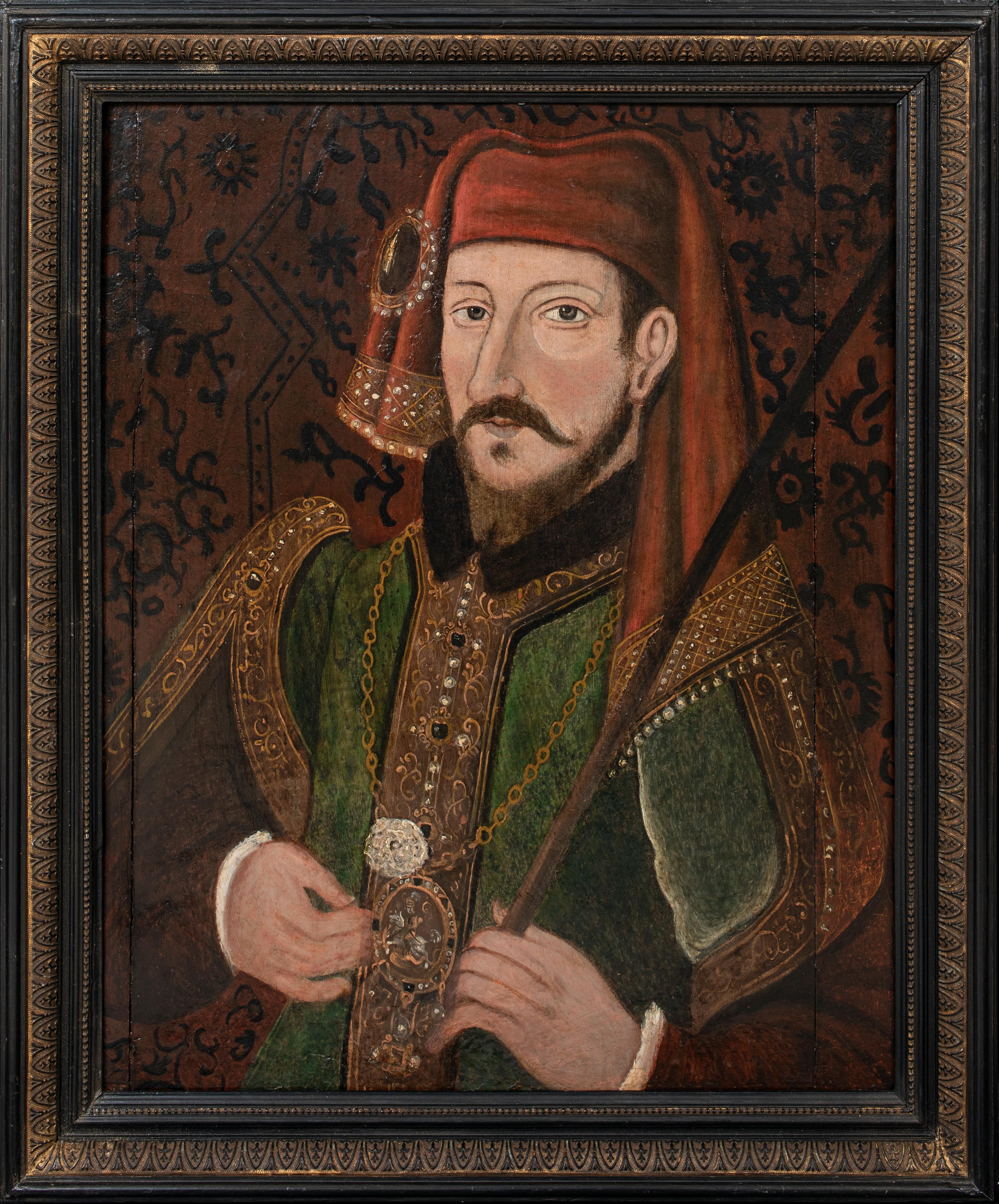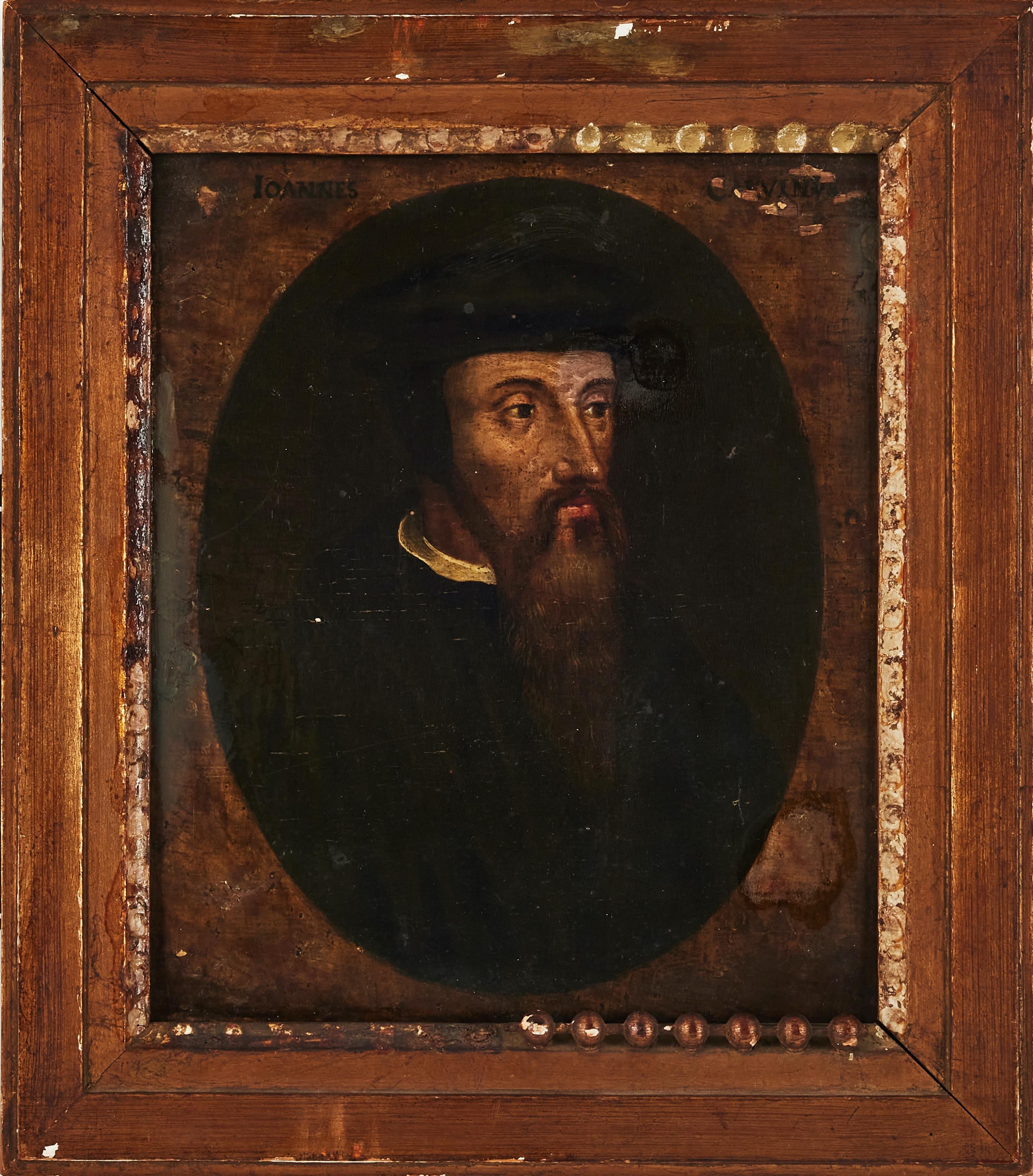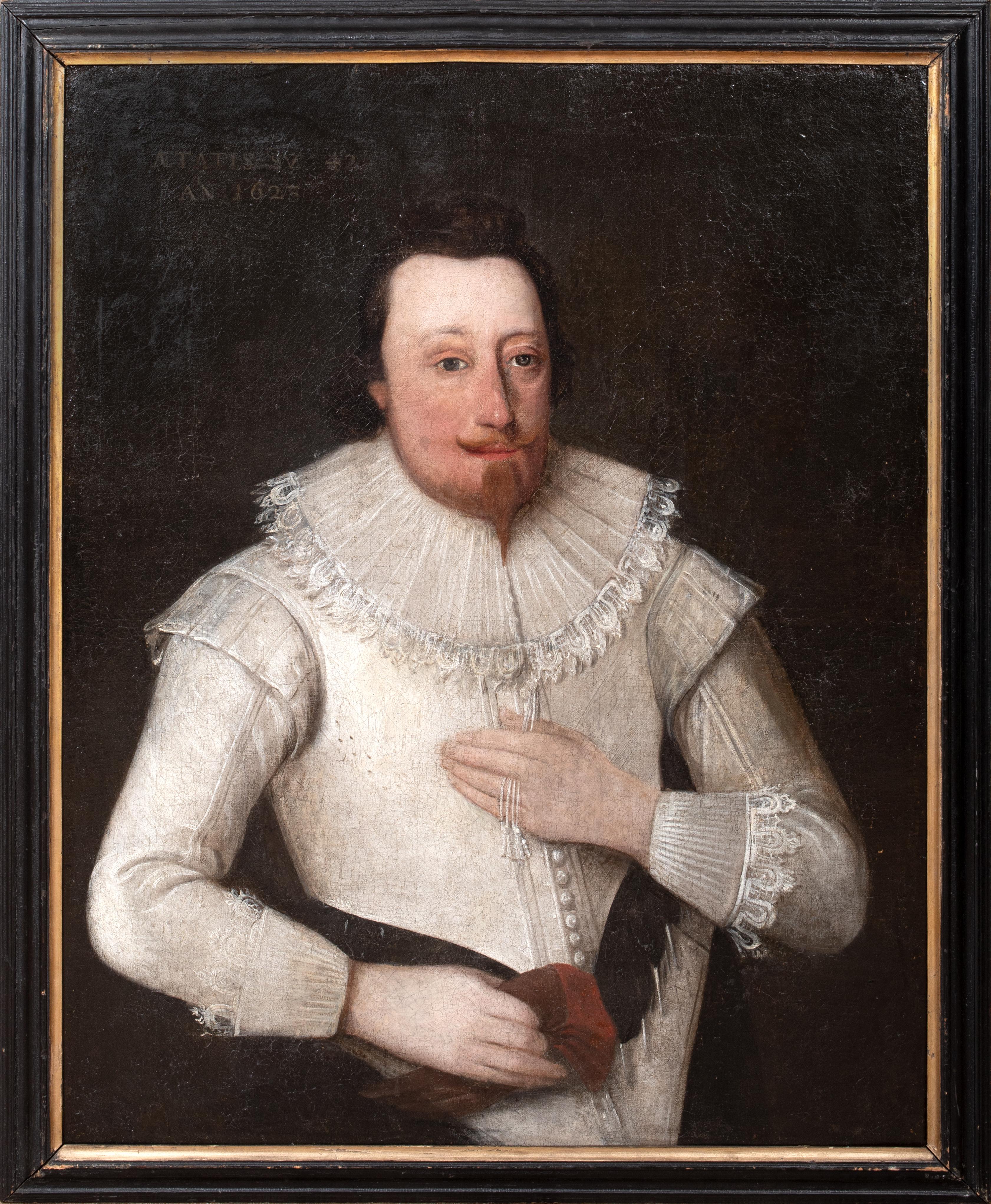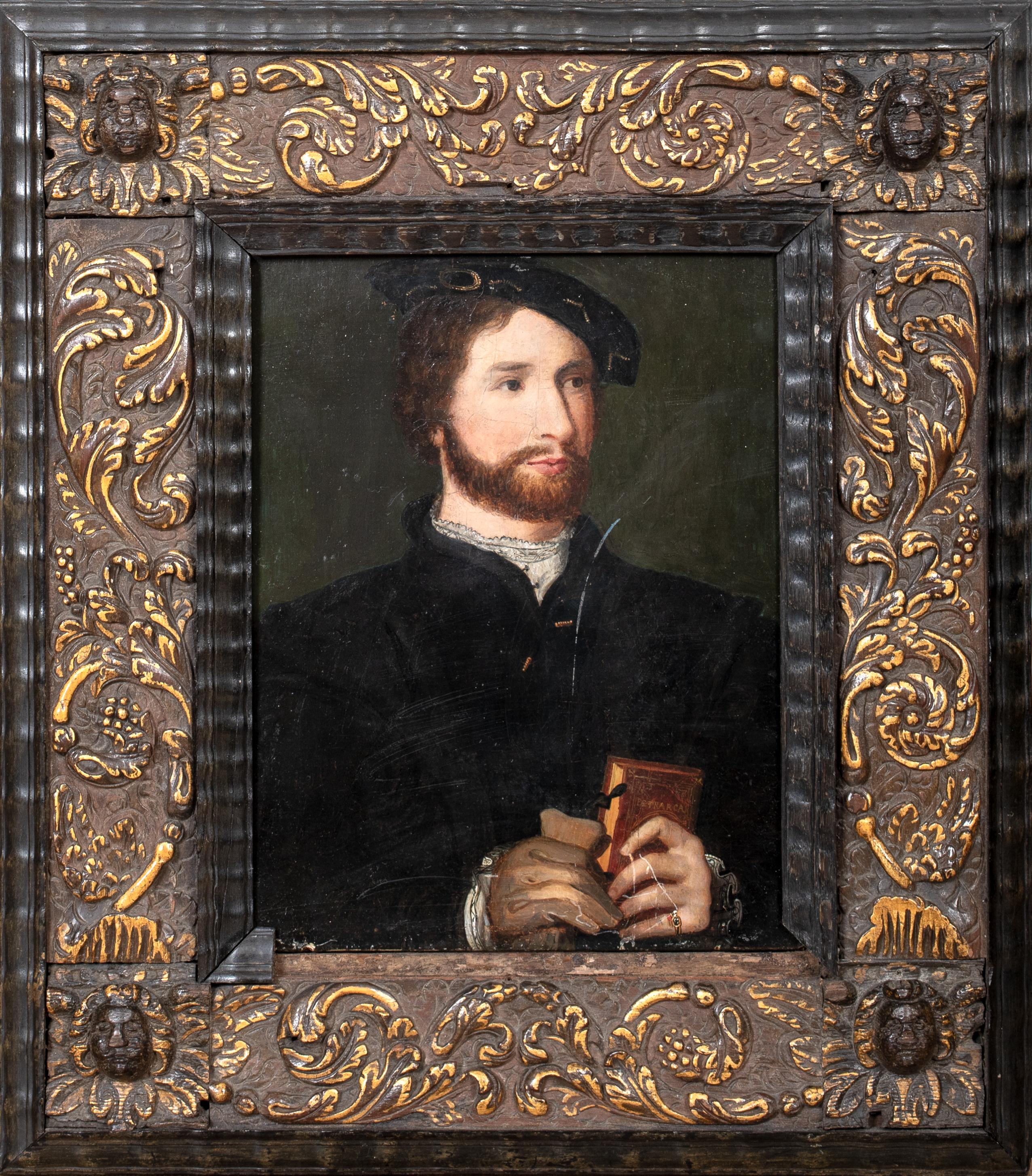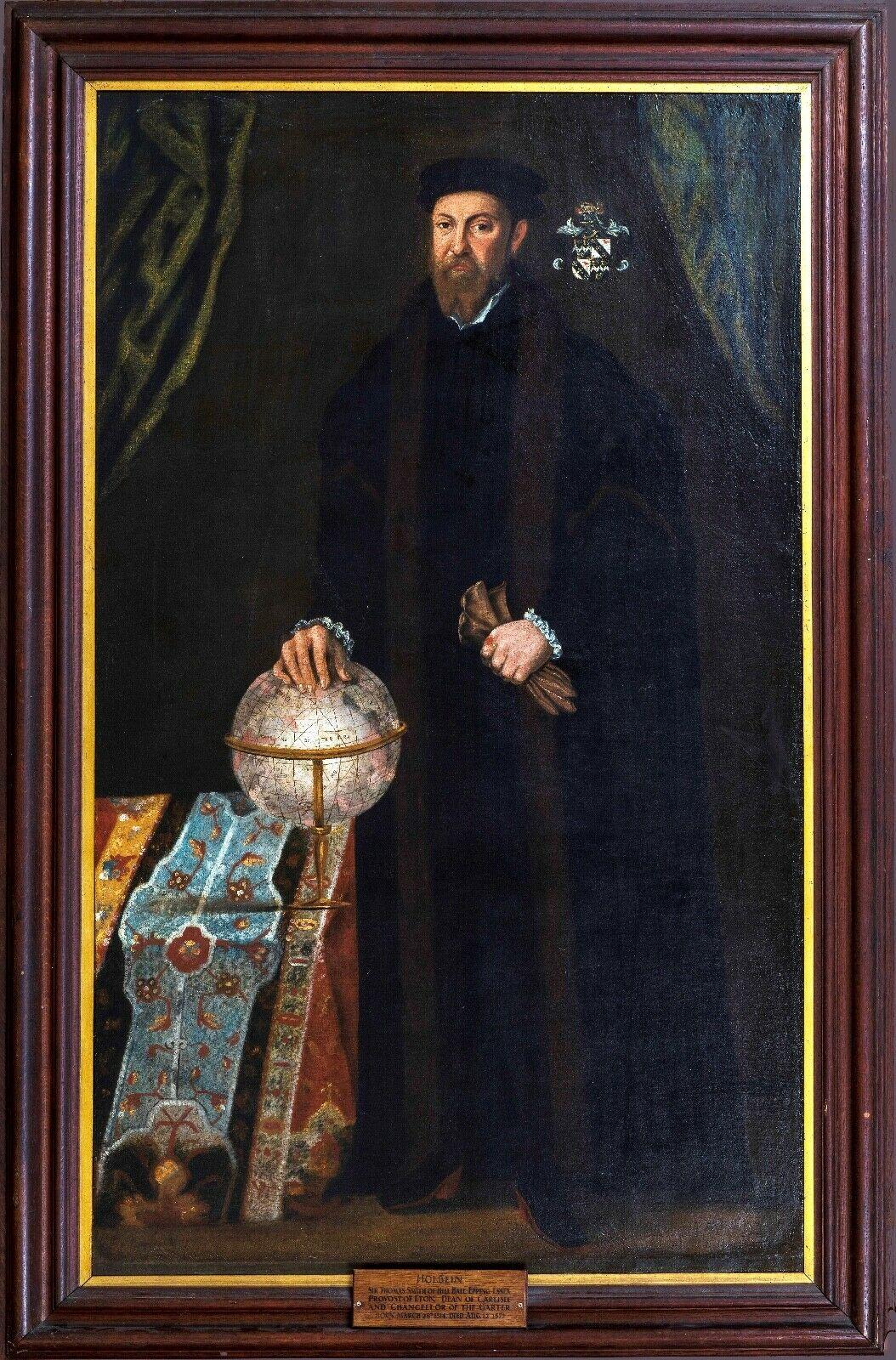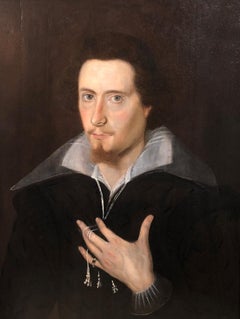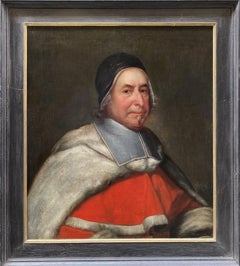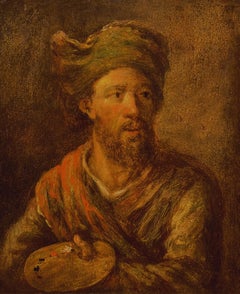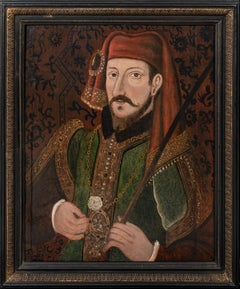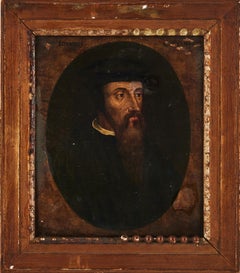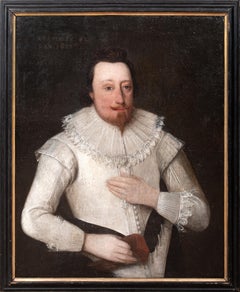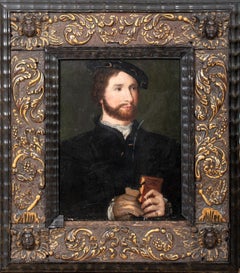Items Similar to Portrait of Geoffrey Chaucer, Oil on Oak Panel Portrait, 16th Century
Want more images or videos?
Request additional images or videos from the seller
1 of 6
Mid 16th Century English SchoolPortrait of Geoffrey Chaucer, Oil on Oak Panel Portrait, 16th Century
$44,767.41
£32,500
€38,311.86
CA$61,561.91
A$68,472.65
CHF 35,837.12
MX$835,140.55
NOK 450,306.44
SEK 423,571.35
DKK 285,960.80
About the Item
Oil on oak panel
Image size: 14 1/4 x 11 3/4 inches (36 x 30 cm)
Period style frame
This portrait shows Chaucer with a string of beads in one hand and a writing implement in the other. The Arms in the top left of the picture are the Arms of Chaucer, featuring a per pale argent and gules, a bend counterchanged.
This painting appears to derive, like all other portraits of Chaucer, from an illustration in an early fifteenth-century manuscript, Hoccleve's De Regimine Principum. Here Hoccleve included one portrait of Chaucer, showing him with an inkhorn around his neck and holding a rosary in one hand. Since it is likely that Hoccleve had met Chaucer, many scholars believe this could be the most genuine representation of the English writer with all other depictions being seemingly based on it.
In almost all portraits of Chaucer, including this one, the poet is shown wearing a pendant attached to his vest. This item is often considered to be a penner, included in the artworks as a sign of the general occupation of a writer. Whilst the pendant is generally accepted as a case for a writing instrument, possibly with equal plausibility, it has also been suggested that the item is an ampulla, a small lead vial containing water and the blood of St. Thomas Becket, given to Canterbury pilgrims as the particular sign of their visit to the martyr's shrine. Usually these served as souvenirs, as legal proof of pilgrimage, and as signs of devotion, but the ampullae also functioned additionally as miraculous relics.
As all portraits of Chaucer were made after his death it is prudent not to view them as historically accurate likenesses but as acts of reverence to the poet. From this view point an ampulla would be a more specific tribute to the poet than a writing instrument, honouring him as the creator of the Canterbury Tales. It also provides additional evidence of the relative popularity of the Tales among Chaucer's works. Furthermore, the ampulla would identify him as a devout man, reinforcing the idea already suggested by the prayer beads he holds in his other hand.
- Creator:Mid 16th Century English School (1501 - 1550, English)
- Dimensions:Height: 14.25 in (36.2 cm)Width: 11.75 in (29.85 cm)
- Medium:
- Period:
- Condition:
- Gallery Location:London, GB
- Reference Number:1stDibs: LU52413909932
About the Seller
5.0
Vetted Professional Seller
Every seller passes strict standards for authenticity and reliability
Established in 2007
1stDibs seller since 2014
82 sales on 1stDibs
Typical response time: 3 hours
- ShippingRetrieving quote...Shipping from: London, United Kingdom
- Return Policy
Authenticity Guarantee
In the unlikely event there’s an issue with an item’s authenticity, contact us within 1 year for a full refund. DetailsMoney-Back Guarantee
If your item is not as described, is damaged in transit, or does not arrive, contact us within 7 days for a full refund. Details24-Hour Cancellation
You have a 24-hour grace period in which to reconsider your purchase, with no questions asked.Vetted Professional Sellers
Our world-class sellers must adhere to strict standards for service and quality, maintaining the integrity of our listings.Price-Match Guarantee
If you find that a seller listed the same item for a lower price elsewhere, we’ll match it.Trusted Global Delivery
Our best-in-class carrier network provides specialized shipping options worldwide, including custom delivery.More From This Seller
View AllPortrait of William Herbert, 3rd Earl of Pembroke, Early 17th Century Portrait
Located in London, GB
English School, (circa 1600)
Portrait of William Herbert, 3rd Earl of Pembroke
Oil on panel, oval
Image size: 29¼ x 23⅞ inches
Painted wooden frame
Provenance:
176, Collection of Francis Greville, 1st Earl of Warwick.
The Trustees of the Lord Brooks’ Settlement, (removed from Warwick Castle).
Sotheby’s, London, 22nd March 1968, lot 81.
Painted onto wooden panel, this portrait shows a dark haired gentleman in profile sporting an open white shirt. On top of this garments is a richly detailed black cloak, decorated with gold thread and lined with a sumptuous crimson lining. With the red silk inside it’s all very expensive and would fall under sumptuary laws – so this is a nobleman of high degree.
It’s melancholic air conforms to the contemporary popularity of this very human condition, evident in fashionable poetry and music of the period. In comparison to our own modern prejudices, melancholy was associated with creativity in this period.
This portrait appeared in the earliest described list of pictures of Warwick castle dating to 1762. Compiled by collector and antiquary Sir William Musgrave ‘taken from the information of Lord & Lady Warwick’ (Add. MSS, 5726 fol. 3) is described;
‘8. Earl of Essex – an original by Zuccharo – seen in profile with black hair. Holding a black robe across his breast with his right hand.’
As tempting as it is to imagine that this is a portrait of Robert Devereux, the 2nd Earl Essex, we might take this with a pinch of salt. Its identification with this romantic and fatal Elizabethan might well have been an attempt to add romance to Warwick Castle’s walls. It doesn’t correspond all that well with Essex’s portraits around 1600 after his return from Cadiz. Notably, this picture was presumably hung not too far away from the castle’s two portraits of Queen Elizabeth I. The first, and undoubtedly the best, being the exquisite coronation portrait that was sold by Lord Brooke in the late 1970s and now hangs in the National Portrait Gallery. The second, described as being ‘a copy from the original at Ld Hydes’, has yet to resurface.
The portrait eventually ended up being hung in the State Bedroom of Warwick Castle.
Archival documents present one other interesting candidate. The Greville family’s earliest inventory of paintings, made in 1630 at their home Brooke House in Holborn, London, describes five portraits of identified figures. All five belonged to the courtier, politician and poet Sir Fulke Greville (1554-1628), 1st Baron Brooke, and were hung in the ‘Gallerie’ of Brooke House behind yellow curtains. One of them was described as being of ‘Lord of Pembrooke’, which is likely to have been William Herbert (1580-1630), 3rd Earl of Pembroke. William was the eldest son of Greville’s best friend’s sister Mary Sidney, and was brought up in the particularly literary and poetically orientated household which his mother had supported. Notably, the 3rd Earl was one of the figures that Shakespeare’s first folio was dedicated to in 1623.
The melancholic air to the portrait corresponds to William’s own pretensions as a learned and poetic figure. The richness of the robe in the painting, sporting golden thread and a spotted black fabric, is indicative of wealth beyond that of a simple poet or actor. The portrait’s dating to around the year 1600 might have coincided with William’s father death and his own rise to the Pembroke Earldom. This period of his life too was imbued with personal sadness, as an illicit affair with a Mary Fitton had resulted in a pregnancy and eventual banishment by Elizabeth I to Wilton after a short spell in Fleet Prison. His illegitimate son died shortly after being born. Despite being a close follower of the Earl of Essex, William had side-stepped supporting Devereux in the fatal uprising against the Queen and eventually regained favour at the court of the next monarch James I.
His linen shirt is edged with a delicate border of lace and his black cloak is lined on the inside with sumptuous scarlet and richly decorated on the outside with gold braid and a pattern of embroidered black spots.
Despite the richness of his clothes, William Herbert has been presented in a dishevelled state of semi-undress, his shirt unlaced far down his chest with the ties lying limply over his hand, indicating that he is in a state of distracted detachment. It has been suggested that the fashion for melancholy was rooted in an increase in self-consciousness and introspective reflection during the late 16th and early 17th centuries.
In contemporary literature melancholy was said to be caused by a plenitude of the melancholy humor, one of the four vital humors, which were thought to regulate the functions of the body. An abundance of the melancholia humor was associated with a heightened creativity and intellectual ability and hence melancholy was linked to the notion of genius, as reflected in the work of the Oxford scholar Robert Burton, who in his work ‘The Anatomy of Melancholy’, described the Malcontent as ‘of all others [the]… most witty, [who] causeth many times divine ravishment, and a kind of enthusiamus… which stirreth them up to be excellent Philosophers, Poets and Prophets.’ (R. Burton, The Anatomy of Melancholy, London, 1621 in R. Strong, ‘Elizabethan Malady: Melancholy in Elizabethan and Jacobean Portraits’, Apollo, LXXIX, 1964).
Melancholy was viewed as a highly fashionable affliction under Elizabeth I, and her successor James I, and a dejected demeanour was adopted by wealthy young men, often presenting themselves as scholars or despondent lovers, as reflected in the portraiture and literature from this period. Although the sitter in this portrait is, as yet, unidentified, it seems probable that he was a nobleman with literary or artistic ambitions, following in the same vain as such famous figures as the aristocratic poet and dramatist, Edward de Vere...
Category
Early 17th Century Old Masters Portrait Paintings
Materials
Oil, Wood Panel
Possible Portrait of William Shakespeare
Located in London, GB
Oil on oak panel
Image size: 17 1/4 x 22 1/4 inches (44 x 56.5 cm)
Period oak frame
This is a portrait of a Tudor gentleman in an open next shirt with one hand raised to his chest. ...
Category
Early 1600s Portrait Paintings
Materials
Oak, Oil
Portrait of a Judge, 17th Century English Oil Portrait Painting
Located in London, GB
Oil on canvas, on board
Image size: 30 1/4 x 27 inches (76.75 x 68.5 cm)
Contemporary style handmade frame
This is a attention-holding portrait of a 17th century English judge...
Category
17th Century English School Portrait Paintings
Materials
Oil, Board
Self Portrait, Oil on Oak Panel, English School, Handmade Frame
Located in London, GB
Oil on oak panel
Image size: 9 x 7 1/4 inches (23 x 18.5 cm)
Period style hand made frame
This is a self-portrait is most likely by a 17th century English...
Category
17th Century Portrait Paintings
Materials
Oak, Oil
PORTRAIT OF WILLIAM WARHAM, Old Masters Oil on Wood
Located in London, GB
after HANS HOLBEIN THE YOUNGER
1497 – 1543
PORTRAIT OF WILLIAM WARHAM
Oil on canvas
Image size: 38 x 35 inches (89 x 71 cm)
Hand made period style frame
The handling of the paint in...
Category
18th Century and Earlier Old Masters Portrait Paintings
Materials
Canvas, Oil
Portrait of Nicholas Poyntz
Located in London, GB
Remigius Van Leemput
Portrait of Nicholas Poyntz
1607-1675
Oil on oak panel
Image size: 13 x 10 1/4 inches (33 x 26 cm)
Contemporary style frame
Provenance
The Dalva Brothers Colle...
Category
17th Century Flemish School Portrait Paintings
Materials
Oil, Panel
You May Also Like
Portrait of Henry IV, King of England (1367-1413), 16th Century
Located in Blackwater, GB
Portrait of Henry IV, King of England (1367-1413), 16th Century
English School Portrait - Early Oil On Panel
Large 16th Century court portrait of Henry IV, King Of England (1367-14...
Category
16th Century Portrait Paintings
Materials
Oil, Wood Panel
$14,325 Sale Price
20% Off
17th Century Portrait of Reverend and Reformer John Calvin
Located in Stockholm, SE
A Rare 17th-Century Portrait of John Calvin
This small interesting portrait, of John Calvin (1509–1564) offers a rare glimpse into the enduring legacy of the French-Swiss reformer. P...
Category
17th Century Old Masters Portrait Paintings
Materials
Oil, Wood Panel
Portrait Of A Gentleman, identified as Robert Carr, Earl Of Somerset (1587-1645)
Located in Blackwater, GB
Portrait Of A Gentleman, identified as Robert Carr, Earl Of Somerset (1587-1645), 17th Century
English Court Portrait dated 1625
Large 17th Century English Court Portrait, possibly...
Category
17th Century Portrait Paintings
Materials
Canvas, Oil
$6,611 Sale Price
20% Off
Portrait Of Henry Howard, Earl of Surrey (1516-1547), 16th Century
Located in Blackwater, GB
Portrait Of Henry Howard, Earl of Surrey (1516-1547), 16th Century
English School Court Portrait
16th century English Court Portrait of Henry Howard, Earl of Surrey, oil on panel. ...
Category
16th Century Portrait Paintings
Materials
Oil, Wood Panel
$5,399 Sale Price
20% Off
Portrait Of Thomas Smythe (1514-1577) School of Hans HOLBEIN (1497-1543)
By Hans Holbein
Located in Blackwater, GB
Portrait Of Thomas Smythe (1514-1577), 16th Century
School of Hans HOLBEIN (1497-1543)
Fine huge 16th Century English Old Master portrait of Sir Thomas...
Category
16th Century Old Masters Portrait Paintings
Materials
Oil
$22,039 Sale Price
20% Off
18th C. Portrait of Edward Stanley from Henry VIII's Court after Holbein Drawing
By Hans Holbein
Located in Alamo, CA
This is an 18th century engraved portrait of "Edward Stanley" created by Francesco Bartolozzi (1728–1815), after a drawing by Hans Holbein the Younger (1497- 1543) in the 16th century. Holbein was the official artist in the court of King Henry VIII. Bartolozzi used both etching and stipple engraving techniques to create the work which was published by John Chamberlaine in London in 1793 in "The Book of Imitations of Original Drawings by Hans Holbein in the Collection of His Majesty".
Edward Stanley, 3rd Earl of Derby...
Category
Late 18th Century Old Masters Portrait Prints
Materials
Engraving, Etching
More Ways To Browse
Antique Hand Paint Portrait
Portrait Pendant
Framed Manuscript
Pilgrim Century
Antique Portrait Pendant
16th Century Oak
Mid Century String Art
Antique Oak Picture Frames
Prayer Beads
Antique String Instrument
Antique Writing Instruments
Beaded Picture Antique
Antique Rosaries
Antique Rosary Rosaries
Pilgrim Portraits
Antique Prayer Beads
Canterbury Tales
Antique Vial
